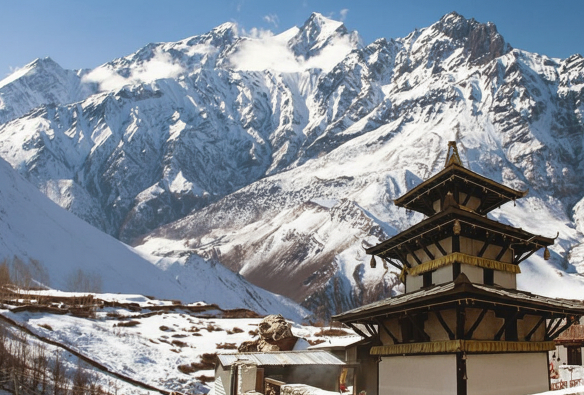
Muktinath (मुक्तिनाथ)
Religious, Mountain
⭐⭐⭐⭐
🇳🇵 NPR 6,000–12,000/day
💵 $45–95
Description: Muktinath is a sacred pilgrimage site for both Hindus and Buddhists, located in the Mustang district. Situated at a high altitude, the site is famous for its temple complex with 108 water spouts and spectacular mountain views, making it a spiritual journey for many.
History & Significance
For Hindus, Muktinath is one of the four main pilgrimage sites in Nepal. The temple is dedicated to Lord Vishnu and is considered a symbol of salvation. For Buddhists, the site is known as Chumig Gyatsa, which means "Hundred-and-eight Waters," and is revered as a site of the Dakinis, or sky dancers. The presence of a continuously burning natural gas flame at the nearby Jwala Mai Temple is also considered a divine miracle.
Key Features
- The main **Muktinath Temple** with its pagoda-style architecture.
- **108 water spouts** arranged in a semi-circle, where pilgrims take a holy bath.
- The **Jwala Mai Temple**, which houses the unique flame burning from natural gas.
- Stunning views of the surrounding Annapurna and Dhaulagiri mountain ranges.
Activities & Experiences
- Taking a spiritual dip in the 108 water spouts to cleanse oneself of sins.
- Visiting the various temples and monasteries within the complex.
- Enjoying the high-altitude atmosphere and the breathtaking mountain scenery.
- The journey to Muktinath, whether by trek or road, is an experience in itself.
Best Time to Visit
The best time is during the spring (March-May) and autumn (September-November), when the weather is clear and pleasant. The site is accessible year-round, but winters can be extremely cold and snowy.
Travel Tips
- Muktinath can be reached by a trek or by a combination of jeep and a short hike. Be prepared for a bumpy road journey.
- The altitude is high, so be aware of altitude sickness and allow time for acclimatization if you are trekking.
- The holy spouts are fed by freezing water, so be prepared for a very cold dip!
- Muktinath can be part of the longer Annapurna Circuit Trek, usually marking the end of the high-altitude section.
⬅ Back to Places
